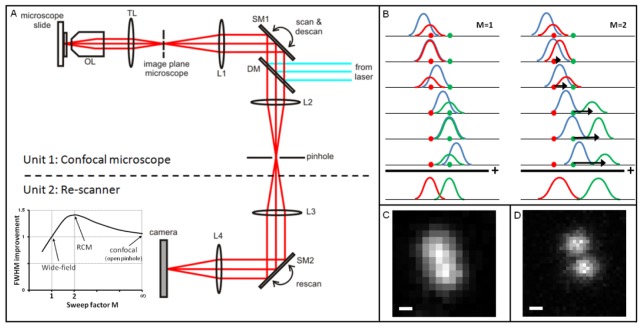Fig. 1.
The Re-scan Confocal Microscope (RCM) (A) consists of two units: 1) a standard confocal microscope with a set of scanning mirrors which have double function: scanning the excitation light and de-scanning the emission light, and 2) a re-scanning unit that “writes” the light that passes the pinhole onto the CCD-camera. The ratio of angular amplitude of the two scanners, expressed by the sweep factor M, changes the properties of the re-scan microscope (see inset in A). For M = 1 the microscope has the lateral resolution of a wide-field microscope, defined by the diffraction limit. For M = 2 the RCM performs best concerning resolution. Even with a wide open pinhole the resolution is √2 times improved, which makes the system much more photo-efficient compared to conventional confocal microscopes with similar resolution (that should have pinhole < 1 Airy unit). For large values of M the system converts to a confocal microscope with open pinhole. (B) The concept of RCM is simple: For M = 1 the two scanners compensate each other and two point-objects (red and green dots) are projected on the camera without extra magnification. When the sweep-factor is set to M = 2, the extra sweep (indicated with black arrows) will smear out the spots on the camera by a factor of √2. Since the distance between the objects is 2 times larger, the relative width of the spots is reduced by a factor of √2. This resolution improvement is clearly visible by comparing C and D. Two 100 nm beads are positioned 250 nm from each other and cannot be resolved by M = 1 (C) but can easily be separated by RCM with M = 2 (D). FWHM in these two configurations was 255 nm and 185 nm, respectively. Scale bars are 100 nm.

